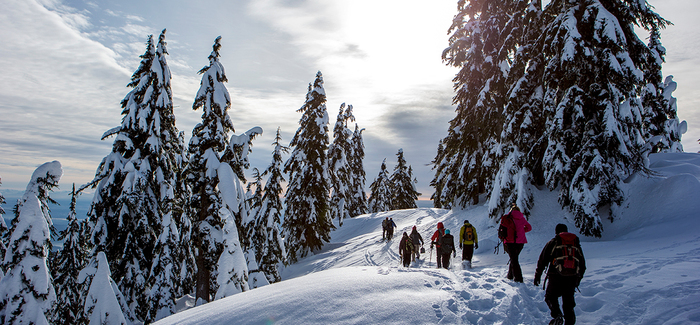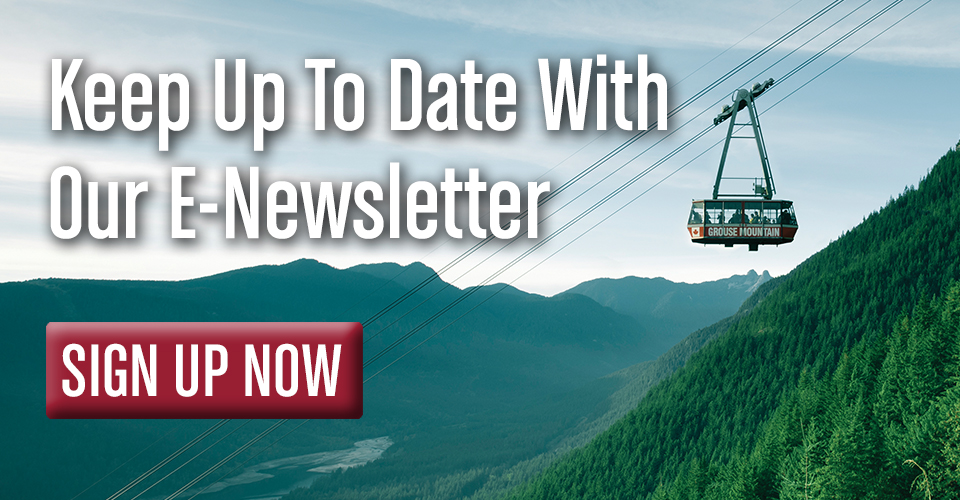
The Importance of Avalanche Skills Training
Learn more during Grouse Mountain's renowned program
Posted by AJ Maheu January 15, 2015
Working as an avalanche forecaster on the North Shore, I see this often: hikers following the path of a summer trail during the winter months and exposing themselves to avalanche hazards without even realizing it.
When most people think of avalanches, they picture an enormous powder cloud rushing down a steep and open mountainside. This image bears little resemblance to a typical hiking trail on the North Shore and there lies the problem. To get a snow avalanche, we need three things: a moderately steep slope, the right snow conditions and a trigger.
1) Most frequently, avalanches happen on slopes between 30 and 45 degrees or the equivalent of a blue or black diamond ski run. The beautiful mature forests that make the North Shore Mountains so special unfortunately do little to anchor the snow to the slopes.
2) We are blessed with a maritime snowpack, which is generally deep and stable. Avalanches on the North Shore often happen during or shortly after a snowfall, usually when people prefer to go skiing and snowshoeing.
3) The vast majority of victims act as the trigger of the avalanche they are caught in by being in the wrong place at the wrong time.
Because of the nature of the terrain on the North Shore, we rarely see very large and dramatic avalanches but we do see a lot of much smaller avalanches that run through very unforgiving terrain. Avalanches run over cliffs, through thick trees, and into open water, gullies or creeks. In the avalanche jargon, we call these “terrain traps”. These terrain features significantly increase the risk of harm or death from a small avalanche. Nearly all the avalanche fatalities on the North Shore were the result of relatively small avalanches coupled with terrain traps.
Avalanche safety is about much more than carrying rescue equipment. The Avalanche Skills Training program is first and foremost about recognizing the hazards, getting the knowledge and the skills we need to make decisions so we never have to use our rescue equipment. Of course, should disaster strike, the training also covers rescue techniques using the three standard pieces of rescue equipment: transceiver, probe and shovel.
As I mentioned previously, terrain traps abound on the North Shore. If you ever have to help an avalanche victim around here, chances are you will also need to deal with trauma. This is where Wilderness First Aid comes in. More on this in a blog post coming soon.
When most people think of avalanches, they picture an enormous powder cloud rushing down a steep and open mountainside. This image bears little resemblance to a typical hiking trail on the North Shore and there lies the problem. To get a snow avalanche, we need three things: a moderately steep slope, the right snow conditions and a trigger.
1) Most frequently, avalanches happen on slopes between 30 and 45 degrees or the equivalent of a blue or black diamond ski run. The beautiful mature forests that make the North Shore Mountains so special unfortunately do little to anchor the snow to the slopes.
2) We are blessed with a maritime snowpack, which is generally deep and stable. Avalanches on the North Shore often happen during or shortly after a snowfall, usually when people prefer to go skiing and snowshoeing.
3) The vast majority of victims act as the trigger of the avalanche they are caught in by being in the wrong place at the wrong time.
Because of the nature of the terrain on the North Shore, we rarely see very large and dramatic avalanches but we do see a lot of much smaller avalanches that run through very unforgiving terrain. Avalanches run over cliffs, through thick trees, and into open water, gullies or creeks. In the avalanche jargon, we call these “terrain traps”. These terrain features significantly increase the risk of harm or death from a small avalanche. Nearly all the avalanche fatalities on the North Shore were the result of relatively small avalanches coupled with terrain traps.
Avalanche safety is about much more than carrying rescue equipment. The Avalanche Skills Training program is first and foremost about recognizing the hazards, getting the knowledge and the skills we need to make decisions so we never have to use our rescue equipment. Of course, should disaster strike, the training also covers rescue techniques using the three standard pieces of rescue equipment: transceiver, probe and shovel.
As I mentioned previously, terrain traps abound on the North Shore. If you ever have to help an avalanche victim around here, chances are you will also need to deal with trauma. This is where Wilderness First Aid comes in. More on this in a blog post coming soon.
About A-J Maheu
Over his ten seasons spent as Patrol Training Coordinator, Avalanche Forecaster and Snowshoe Park Supervisor, A-J Maheu has been a tireless advocate for backcountry safety. Working alongside a team of highly-skilled and dedicated ski patrollers, the Montreal native considers the most defining moments of his life to be those spent traveling in the backcountry, all the while developing a deeper understanding our connection to the natural world. When not passing along his knowledge to others, you’ll find A-J skiing, climbing, cycling or sea kayaking.

